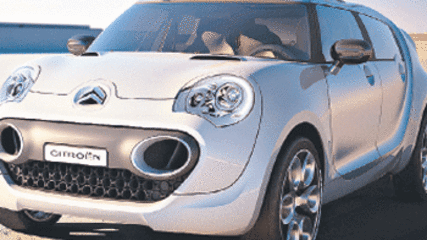Citroen C4 Cactus News

Citroen C4 Cactus revealed
Read the article
By Karla Pincott · 05 Feb 2014
Citroen is known for being a bit quirky, and they've amped up that 'bit' to 'a whole lot' with the coming C4 Cactus, which has not moved far from its funky concept styling.Set to be unveiled at the Geneva motor show next month, the C4 Cactus carries over most of the cues from last year's Frankfurt Cactus concept -- most notably the 'airbump' panels along the sides, designed both for visual impact and to protect the vehicle against the scuffs of real impact.However the side openings have been replaced by more conventional pillared windows, although blacked out to retain the appearance of a floating roof. And the concepts 'circuit board' headlights and tail-lights have been ditched in favour of normal LED clusters.The interior has kept the vented leather upholstery on bench seats with strong metal accents and the floating screens for instrumentation and infotainment.Citroen has not yet revealed any drivetrain details for the C4 Cactus, however we expect the show reveal to include information on economy-focused petrol and diesel engines.
W.jpg)
Citroen Cactus concept revealed
Read the article
By Paul Gover · 11 Sep 2013
Here's a smooth newcomer with a spiky mission for Citroen. As the French maker uses a style-driven push in Australia with its DS line, its Cactus concept is unveiled this week to preview the thinking behind a revitalisation of its mainstream C-Line models.Citroen believes the design of the Cactus crossover is the look that will work for people who buy cars for transport, although it's not backing away from its aspiring-for-prestige position down under. It's not as outrageous as some recent sports car dream machines, but it's not just a boring box."The French are renowned for flair and cutting-edge design and that won't disappear. It's in the DNA," the head of Citroen Australia, John Startari, tells Carsguide. "The global strategy concentrates on product development and the C-Line range will be pitched as the more-affordable models."So Startari confirms that Citroen is working closely with Peugeot in Australia, dovetailing their lineups with the top end reserved for his DS models, as they work under the shared ownership of the Sime Darby group. "That's to stop cannibilisation in the PSA stable," he says.Looking closer at the Cactus, Startari sees potential for Australia even though the Frankfurt motor show car is revealed with left-hand drive. "Citroen has tended to go into production with the majority of its concepts, so . ," hints Startari."It's too early to determine if it will come to Australia. But we've a hot, dry country and there is a certain resonance." Among the design work on the Cactus is a 'driver's station' with controls in a fully-digital interface, sofa-style front seats, natural materials and what Citroen calls 'non-aggressive flowing surfaces' for the body.Technology work starts with lightweight body panels, 'airbumps' to protect the body, and a hybrid drivetrain - incorporating compressed air and hydraulics - that promises 2.5 litres/100km economy.This reporter is on Twitter: @paulwardgover

C-Cactus one sharp operator
Read the article
By Stuart Innes · 28 Nov 2007
Citroen names the latest concept car C-Cactus; seeing it as a possible car of the future. The C-Cactus name is chosen because of the perception that the desert-dwelling plant needs little water to survive.The inference is this car needs little in the way of fluids (fuel) to keep going it.Citroen has built this C-Cactus car as a hybrid using a small diesel engine as well as an electric motor. And it has concentrated on light weight; meaning less energy is used to accelerate and keep the car at cruising speeds.The turbodiesel engine delivers about 52kW of power and the electric motor another 22kW when called on for assistance.Like existing hybrid cars, for urban driving there will be moments when the C-Cactus runs only on its electric motor. It's what Citroen calls ZEV mode (zero emission vehicle). The diesel engine has a particulate filter system. Fuel economy officially is rated about 3.4 litres per 100km and emissions therefore are a low 78g/km. Top speed has been capped at 150km/h.A key feature of the Citroen C-Cactus is the weight saving brought about by using fewer components, much of that achieved by combining tasks into one component.The cabin takes 200 parts to create, or about half the number of a conventional car of similar size. Even the dashboard is gone. Its functions, gearbox controls, navigation system and a few speakers of the sound system are all incorporated into a stylish centre console.Door panels are made of two parts instead of the expected 12. The car has an automatic airconditioning system, so Citroen argues that there's little need to open the windows. Thus, the window winding or power opening systems are not there: simple sliding panes do the job instead.C-Cactus has appeared wearing 21-inch wheels with special tyres that have been developed in conjunction with Michelin.




